Onychomycosis is mushroom damage to the nail plate. The disease can be caused by dermatophyte mushrooms or microsporia. The mushrooms have a negative impact on the construction basis of the nail - keratin and gradually cause it to change deformation.
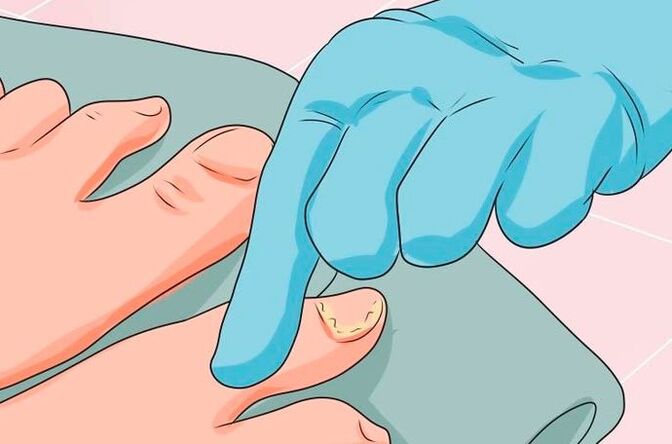
The following types of onychomycosis exist:
- Normotorophical. Change the color of the nail, the appearance of stripes and stains.
- Hypertrophic. Not only the color change occurs, but also a slight deformation. Most of the time, the nail is deformed by the edges.
- Onycholithic. The nail is destroyed, atrophied and rejected.
The fungus on the legs of the legs appears not only because of a decrease in immunity. About 70% of people are infected by a sick person, and mostly they are a relative. The smallest scales of the skin from the feet fall on household items and infect a healthy person in contact with healthy nails or skin tissue.
Most of the time an infection occurs:
- Washy.
- Sponges.
- Towels.
- Carpets.
- Shoes.
- Manicure accessories.
When visiting the beach, the sauna and bathrooms without slippers, there is a high risk of infection with a mushroom of the legs. In the case of high humidity and temperature, an infection occurs much more often.
It is particularly attentive to be in public places where people go barefoot. The mushrooms are resistant to both low and high temperatures, and in the beach sand they retain their viability for several months.
Healthy tissues are gradually affected by a mushroom. A lot depends on what type of pathogen, but some signs allow us to distinguish several main stages of the development of onychomycosis:
- Normotorophical or initial. There are no pronounced manifestations, at this stage it is difficult to notice an infection with a fungus. The nail becomes matt, its color can change easily, small cracks occur, irregularities on the surface. Burning and itching can be felt. This time is easy to confuse with other diseases: psoriasis, changes in the liver. In order to confirm the diagnosis, it is therefore recommended to contact a dermatologist.
- The hypertrophic form arises if no measures are taken in the initial stages. The symptoms are becoming more and more pronounced. The nail thickens and darkens, the shape of the plate is deformed, it crumbles and destroys.
- Atrophic or neglected. It appears when the infection extends to the cuticle, leans the latter, inflammation and swelling. The entire surface of the nail plate changes its color, it is completely separated from the bed. The treatment can be ineffective, the nail is not always saved due to its atrophy.
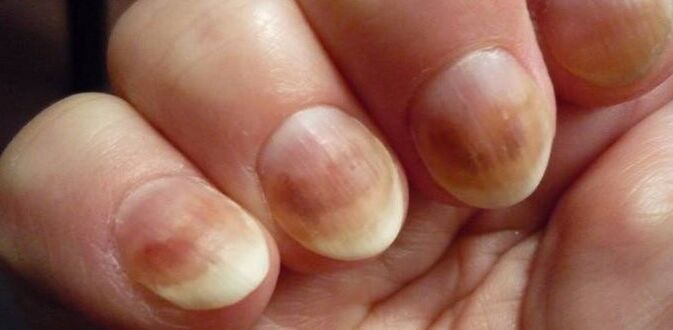
Signs of nail fungus:
- The nail plate begins to change the shadow, it becomes dull. As a result, it loses a healthy pink color. When the fungus parasitates on the surface, the nail becomes white or yellowish. Most of the time, most often happens on the fingers. With other types of damage, the nail can take every color: from greenish, gray to black.
- Thickening or exhaustion of the nail plate - if you find that the thickness of the nail has changed, this is a clear sign of mushroom damage. At the same time, the nail plate loses elasticity, becomes rough, hard or vice versa, begins to crumble. The normal thickness of the nail on the fingers does not exceed 0, 5 mm, the nails of the legs up to 1 mm.
- The layer of the nail plate, its delay behind the surface of the nail bed is a sign of the advanced stage of the disease when the structure of the nail changes. It becomes relaxed, uneven, covered with furrows.
- A discomfort - to understand that a mushroom has occurred on the nails through unpleasant sensations that accompany this disease. There is a strong itching, sometimes painful sensations.
- An unpleasant smell - this symptom is particularly characteristic of onychomycosis on the nails of the toes. If you smell uncomfortably despite the regular implementation of hygiene methods, you should see a doctor.
Nail fungus is often accompanied by an extremely unpleasant smell
The general symptoms of the disease are listed above. But how specific onychomycosis manifests itself depends on the type of mushroom that impressed the nail plate.
Every variety of mycosis has typical signs:
- Fleet fungus - leads to a quick thinning of the nail plate. It breaks, starts peeling out of the nail bed. The shadow of the nail first becomes yellowish and then gets a brown color. In a neglected form of the disease, the skin swells around the nail.
- Mold - parasitize on the surface of the nail plate, without penetrating deeper. Thanks to this, this type of illness is easier to treat than the rest. The main sign of the disease is a change in the color of the nail. Everyone can be the shadow: from white, green to gray, black. If you do not start the correct treatment in time, the fungus spreads to other nails and even the skin. There is severe itching, pain, especially when walking.
- Dermatophytes - develops when the nail from Trichophyton SPP. As well as epidermophytone SPP and Microsporum sppp. Is influenced. The first signs of this disease - stains or gray, yellowish shadows are formed on the nail plate. With progressive illness, your amount increases and the nail begins to peel.
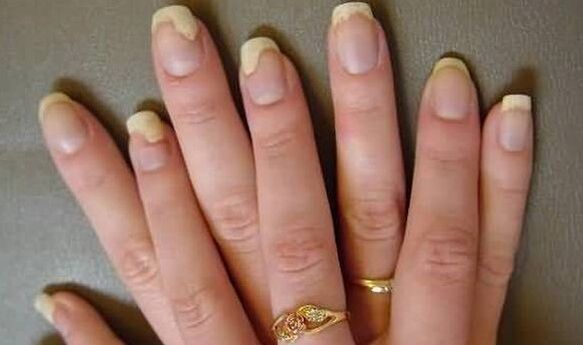
Dermatophytes one of the common forms of nail fungus
Knowing what kind of mycosis of the nail was very important for the right treatment. The active components of most pharmacological medicines are designed in such a way that they destroy a certain mushroom type.
Onychomycosis begins with the lesion of insignificant parts of the nail, so many people initially do not pay attention to a change in shadow and the formation of stains. In the absence of treatment, mycosis spreads quickly enough, which influences all the large areas of the infected nail, switch to healthy nails and infect others.
There are 3 development stages of nail mycosis:
- The initial phase - drives without clearly expressive symptoms, unpleasant sensations such as itching and pain are often missing. Small spots, strips, intermediate shots that are hardly distinguishable appear on the nail plate. It is easiest to notice them on the thumb.
- The second or progressive phase of onychomycosis - the number of spots and grooves takes too large and is already clearly noticeable. The color of the nail plate changes, fades and begins to deform.
- The advanced level - the nail plate completely loses the aesthetic appearance, it is excessively thick or very brittle. The color of the nail becomes yellow, brown, green, black. It isolated, there is a risk of a complete loss of the nail.
The first signs of the presence of nail fungus
The earlier it is possible to recognize onychomycosis, the higher the likelihood of getting rid of this disease quickly. With competently operational therapy, the body only suffers minimally. So if you appear the first symptoms of mycosis, you have to consult a doctor.
The first signs of nail mycosis occur almost immediately after the infection. When after visiting public places such as a pool, a sauna, the shower in the gym, the beach, the nails faded, they began to itch a little, then these are the first signs of onychomycosis.
Healthy nails are practically not susceptible to infections with a mushroom. It begins to develop quickly if they only on damaged nail plates.
Folk remedy
There are many folk remedies that help heal nails that are affected by a mushroom in the initial phase. Consider effective, but at the same time simple recipes.
Sometimes ordinary iodine can help to deal quickly with the mushroom
- Iodine - daily until the symptoms disappear, turn 1 drop of iodine 5% on the affected nails. The procedure is carried out both in the morning and in the evening. More material about the treatment of iodine.
- 1 teaspoon of iodine, vinegar, glycerin is mixed with 6 teaspoons of water and diluted. The resulting mix for 10 days in a row rubs the nails. The composition on the nail plate must remain overnight.
- Vinegar - Prepare a bathroom by diluting 1 part vinegar 9% with 8 parts of warm water. Come up in her legs or arms for 20 minutes. Perform 7 procedures every other day. More material about the treatment of vinegar.
- Ointment from the egg - Put a raw chicken in the shell in a glass and pour 9%vinegar upwards. When the bowl dissolves, remove the rest of the film and mix the egg with vinegar. The resulting mix is applied twice a day for 2-3 weeks to the affected areas.
The ointment of chickens is also very effective against the mycosis of nails

- Hydrogen peroxide - Dilute 2 tablespoons of hydrogen peroxide 3%in 2 liters of water. To increase your hands or legs, depending on where the mushroom is located for 20 minutes. Repeat the process for 7-10 days in a row.
- The compress of peroxide - to impregnate a cotton smear with peroxide, attach it to the nails on which there are signs of the mushroom. Before that, the arms or legs in the soda bath must be afraid. To prepare it, 1 teaspoon of soda is diluted in 1 liter of water. The compress above is packed with cellophan or food film and is left for 60 minutes. This is necessary so that the peroxide does not evaporate. Repeat the process twice a day 10 to 14 days.
- Propolis tincture - Wet a cotton smear into the alcohol tincture of propolis 20% and attach to the affected areas. Keep the lotion while the composition dries. Repeat every day until recovery. 1-2 procedures are sufficient per day.
- Washing powder - The method is suitable for the treatment of leg nails. It is necessary to dissolve 100 g of washing powder, which contains many alkali in 2 liters of water. Hold in such a bath for 15 minutes. Repeat 10-14 procedures while the symptoms disappear.
- Garlic - cut a peeled clove of garlic, wet in salt and then rub the nail plate. Repeat twice a day before the symptoms disappear.
- Ammonia - Dilute 1 tablespoon of ammonia in 1 glass of water. The resulting solution is impregnated with cotton fabric. It has to wrap your legs or arms and leave this compress at night. Repeat the process for 7 days a day.
- Onion - grind the onion to the consistency of the porridge and attach to the affected nails for 30 minutes. Repeat this twice a day before recovery.
Holded onions help to give up your nails a healthy look
- Mix chamomile, wise mint, you can take dry or fresh herbs. Place the resulting composition in a toe or glove at night. Herbs have to be changed every evening. Repeat the procedure in combination with other recipes, while the symptoms of the mushroom disappear.
- Boric acid - cotton smears impregnated with boric acid are applied to pre -operated nails. You have to keep the lotion for 30 minutes. The procedure is repeated for 10 days in a row every day.
- Celandine Öle and Teholz -Mix these products in the same ratio, soak the Gaze Association with the resulting composition and apply them to nails for 20 minutes for 20 minutes. The recipe is contraindicated in pregnant women.
- Soda - dilute soda with a small amount of water to the consistency of porridge. Apply it to the nails for 20 minutes and then rinse twice a day with warm water twice a day a day.
- Apple cider vinegar - dilute it with olive oil. The required share is 2 parts of vinegar up to 1 part of the oil. Apply the mixture to the affected nail plates, while the nail grows completely.
- Tea tree oil - apply a few drops of oil on the nails, while the areas of the nail plate affected by the mushroom grow completely.
- Verba - 500 g of a young pasture, pour 2 liters of water, bring to a boil. Make baths for hands or legs three times a week from the finished decoction three times a week.
- Nettle - brew 3 tablespoons of nettles in 400 ml of water. Get wet tampons with this decoction and apply it to the nail plates twice a day before recovery.
- Grind the leaves of the mountain ash and put them on the nails with a thick layer and then wrap them with a back film for 30 minutes. Repeat the process for 12-14 days a day.
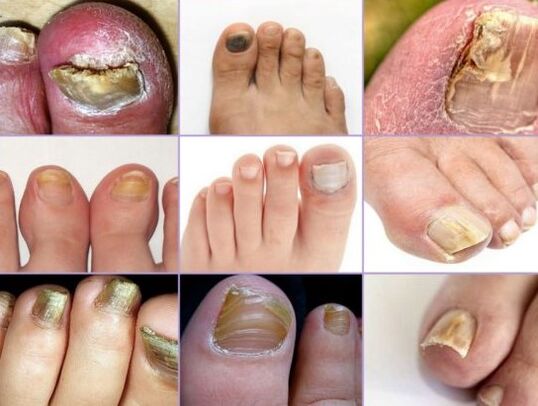
- The mushroom of the skin of the feet.
- Reduce immunity.
- Family members who suffer from a mushroom.
- Older age.
- Diabetes.
- The presence of microtraumas and burrs.
- Increased sweating of the legs.
- Unknown and bad shoes.
- The habit of walking barefoot in public places.
- Accommodation and work in a wet climate.
- Long -term artificial nails.
- General health.
- Susceptibility to infections.
- The degree of moisture and thermal background.
- The type of nail plate (nails on the fingers slow down).
- Distal U -Boat -onychomycosis.
- Lateral onychomycosis.
- White surface onychomycosis.
- Proximal tray onychomycosis.
- Total dystrophic onychomycosis.
How can you get an infection with a mushroom?
An infection with mycosis of nails can occur anywhere: from public locations to their own home. It is transferred directly to people and objects with which a person who suffers from mycosis contacts. The fungus penetrates through micro -rises, bruises and other damage.
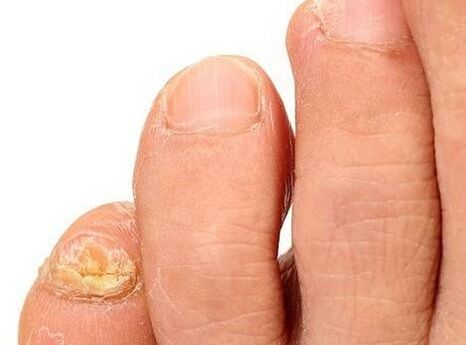
Places where they can be infected with mycosis:
- Public places where people often go barefoot, especially when the humidity is increased there. In such a microclimate, Mikoz keeps life. Examples of such institutions are souls in fitness centers, saunas, baths.
- Chests of drawers in shops, sports complexes and other places.
- Manicure spaces - if the master does not process the tools badly after making a manicure or pedicure with a mushroom, there is a very high probability that the next client is infected with this disease.
- Visit and at home - When a person attracts clothes, shoes in which the fungus whereabouts remaining, a towel that she had previously used by onychomycosis. The fungus may be on the nails when they go barefoot on the floor.
- Beach - there are always many mushroom disputes in the sand on the beach. If you go barefoot, you will penetrate microricises and diseases cannot be avoided. You can also infect yourself by a sun lounger on the beach.
- Public transport - through the handrails according to which the patient touched.
- Shop - while trying on the bare foot of the shoes that had previously measured the patient with a mushroom of nails.
There are great opportunities to get infected with a mushroom by nails in public transport
In the places above, you should be extremely decent to avoid infection.


















